
In the world of transit, buses generally aren’t considered very glamorous. For most people, mention the modest bus and they might sigh at the thought of waiting in the cold without the certainty of when – or even if – your ride will show up. In general bus services are implemented poorly and are not well liked by those who use them.
But there’s a better way. In Taras Grescoe’s book Straphanger, the writer globe-trots to visit transit systems around the world. Amongst such transit gems as Tokyo and Paris, he also visits Bogotá, a city which has thrived on its Bus Rapid Transit (BRT) network, and characterises it as The Revenge of the Loser Cruiser. Well, now BRT has come to Montreal and you know what? It’s good.
Around these parts, 90% of the excitement around transit is justifiably focussed on the REM, a project which is 50% exciting and 50% controversial (depending on whom you speak with) and also incidentally a project which is 100% delayed. Yet there has been another transit project here in Montreal which will make a positive impact to many travellers in the city’s East. It is the Pie IX BRT.
(Note: For non-Francophones like me, “Pie IX” pronounced like “Pea Neuf” by the way, and named after Pope Pius the 9th, a nod to the province of Québec’s catholic roots)
Arrival
When you approach a BRT station, you’ll find the usual striped crossing at the traffic intersection.

Mid-way along the intersection is an entrance to the shelter. This point also acts as a kind of traffic island, so if you’re exiting the station you have somewhere safe to wait until the lights let you across. It also means the stations are equally accessible from either side of the road.

The striped crossings are highly visible – in contrast to many pedestrian crossings in Montreal – although it remains to be seen if they are maintained through the harsh winters.

Once over the crossing, a gentle ramp takes you safely into the station itself. Perhaps calling it a “station” could be seen as a colourful euphemism for a shelter with delusions of stationhood. But it’s equipped with digital displays, help points and plenty of space. These are amenities you won’t find in your average bus shelter.
Signage and Displays
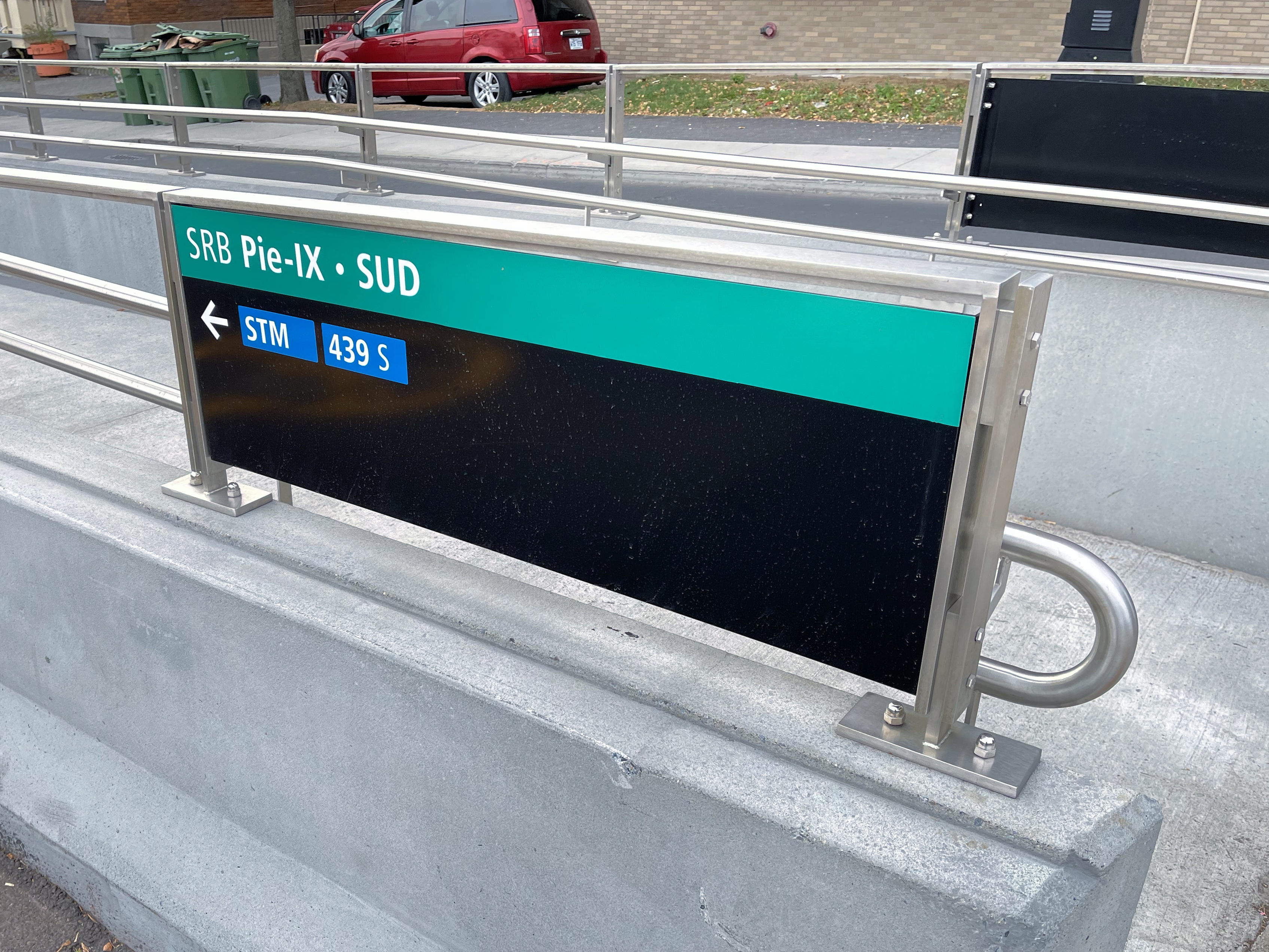
Signage in general is excellent. From when you approach the stations from the street, there are indicators mid-way along the crossing directing you onto the ramp to the shelter, clearly stating whether the direction is North or South.
It’s refreshing to see cardinal directions on transit signage in Montreal, as on the Metro directions are by terminus. For example, on the Green Line trains don’t go “West”, they go to Angrignon. This is likely due to the fact the Metro lines have a habit of curving back on themselves, so it’s good they’ve taken advantage of the BRT’s simple North / South axis and apply it to the signage.
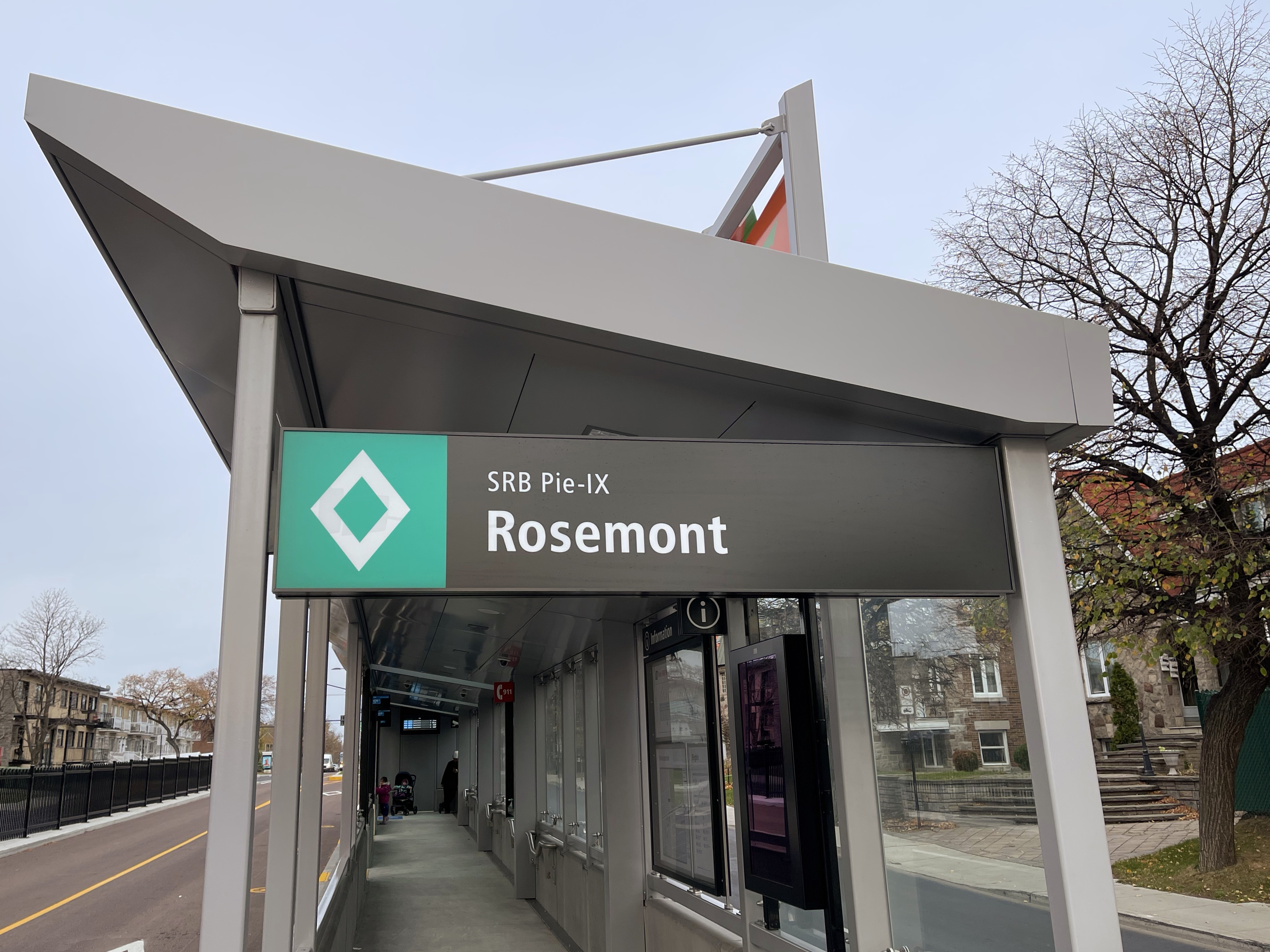
The station names are clearly displayed in multiple places around the shelter, and also visible from the buses themselves. One improvement I would have made is to have also have had display boards on the opposite side of the bus, so passengers on a crowded bus can see the station no matter which side they’re seated.
A nice touch is when the automated audio announcements onboard state the station name (eg: “Rosemont SRB”) rather than the typical cross-street format (eg: Pie IX / Rosemont). This said, the dot-matrix displays on the buses do continue to use the latter way of displaying the stops, but this results in a slight lack of consistency.

Within the shelter are multiple screens showing bus information. The larger screen shows the next nine departures! (I wish the STM would install similar display screens on the metro, but that’s a whole other story).
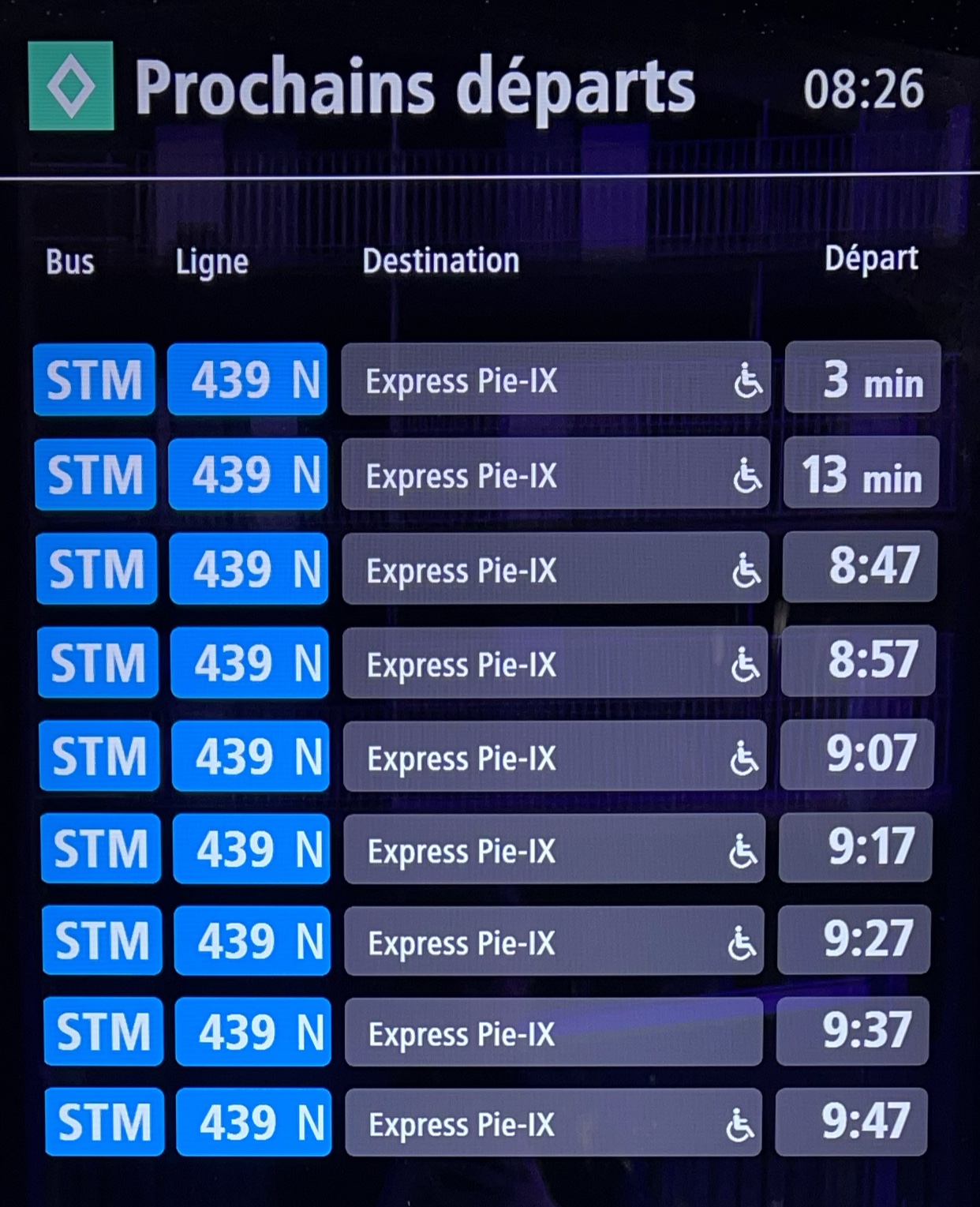
Whilst I can’t yet validate the accuracy of the timings shown on the displays, I did open up my transit app of choice and could see the BRT arrivals clearly marked and being tracked as I’d expect, so everyone got their data in order in time for the opening.
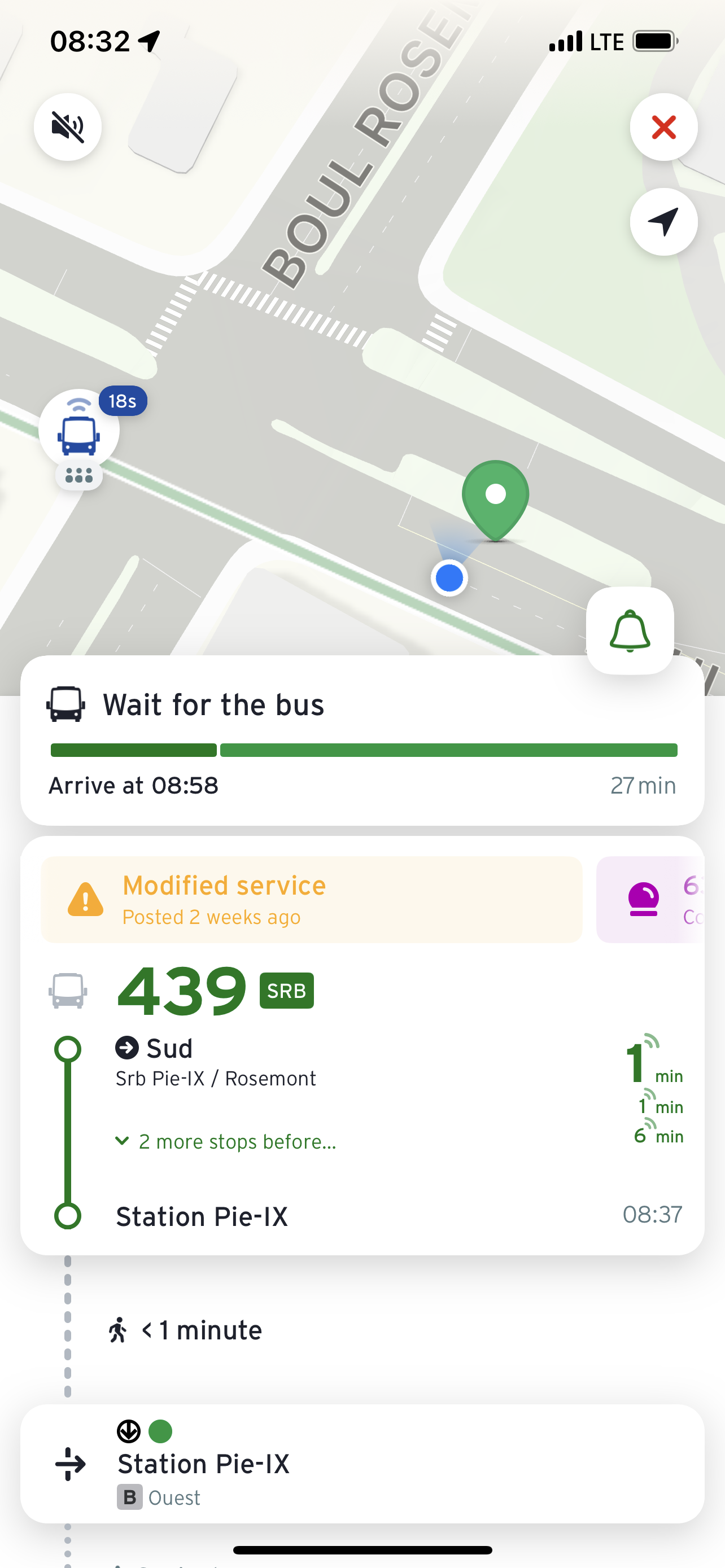
But regardless, these displays are surely a gold standard for passenger information and outstrip anything the STM has implemented to date.
Station Facilities
The shelters themselves are spacious and protected. Whilst it remains to be seen how well they protect riders from the harshest days of a Montreal winter, they are light years ahead of your regular bus stop.
What’s interesting is the lack of ticket machines in these stations. Tickets have to be bought in advance, or single fares can be purchased on the bus. This makes me wonder how one buys the correct fare when travelling to the Northern terminus in fare Zone B, as typically it’s only possible to buy a Zone A fare on an STM bus.
This could prove problematic for someone not holding a season ticket. If you’re starting your journey at the Metro station, the ticket machines there will provide you with a ticket to where you need to go. I noticed the display on the front of the bus does show “Zone B” if that’s where it’s heading, so you do get at least a clue your standard ticket may not be suitable before you board.
Another thing which differs from other bus routes is the placement of the bus stops after junctions instead of before. I know the general placement of bus stops before junctions annoys some people, who feel the buses miss their chance to get through the lights, but in this instance they’ve elected to get buses over junctions before making a stop.
The stations themselves contain three openings which line up with the doors of the bus when it arrives. This creates a neat interface between the bus and the station, protecting passengers from the elements.
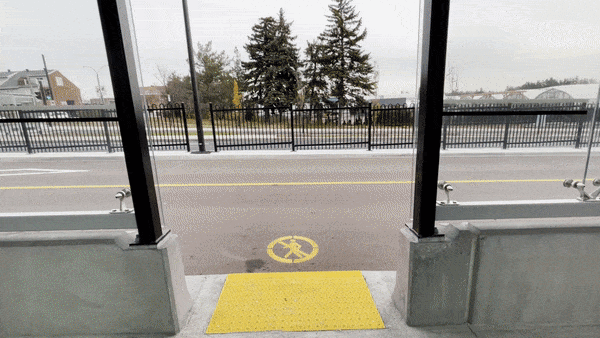
I do have a few comments about this though. Firstly, it highlights how thin the two back doors are on these articulated buses. There’s not much space to get off when it’s crowded, and when you consider the wide openings of the station it pulls into perspective the inadequacy of these doorways.
Secondly, it would have been nice to have doors on the shelter as well, akin to platform screen doors which are becoming commonplace on metro systems around the world.
Finally, I noticed the bus driver only opened the front door for boarding passengers. This is standard practice across most STM routes, except at terminal stops. But, it doesn’t make sense to do this at BRT stations, especially when there are card readers at all three of the doors.
One of the things I really like about the stations is their location on a central reservation. Without doubt, one of the least pleasant parts of a regular bus stop experience is one’s proximity to fast moving traffic. Here, the traffic runs behind the shelter, so there’s a pane of glass between you and the cars as you face out towards the protected central bus lanes. This significantly reduces the noise and probably somewhat reduces the exposure to pollutants.
Making Connections
What really threw me for a loop was the lack of a proper station by the Metro itself. In what I would have expected to be the crowning glory of the whole BRT system – the one location which would have the most people making transfers between the BRT and the Metro – we only get a temporary bus stop.
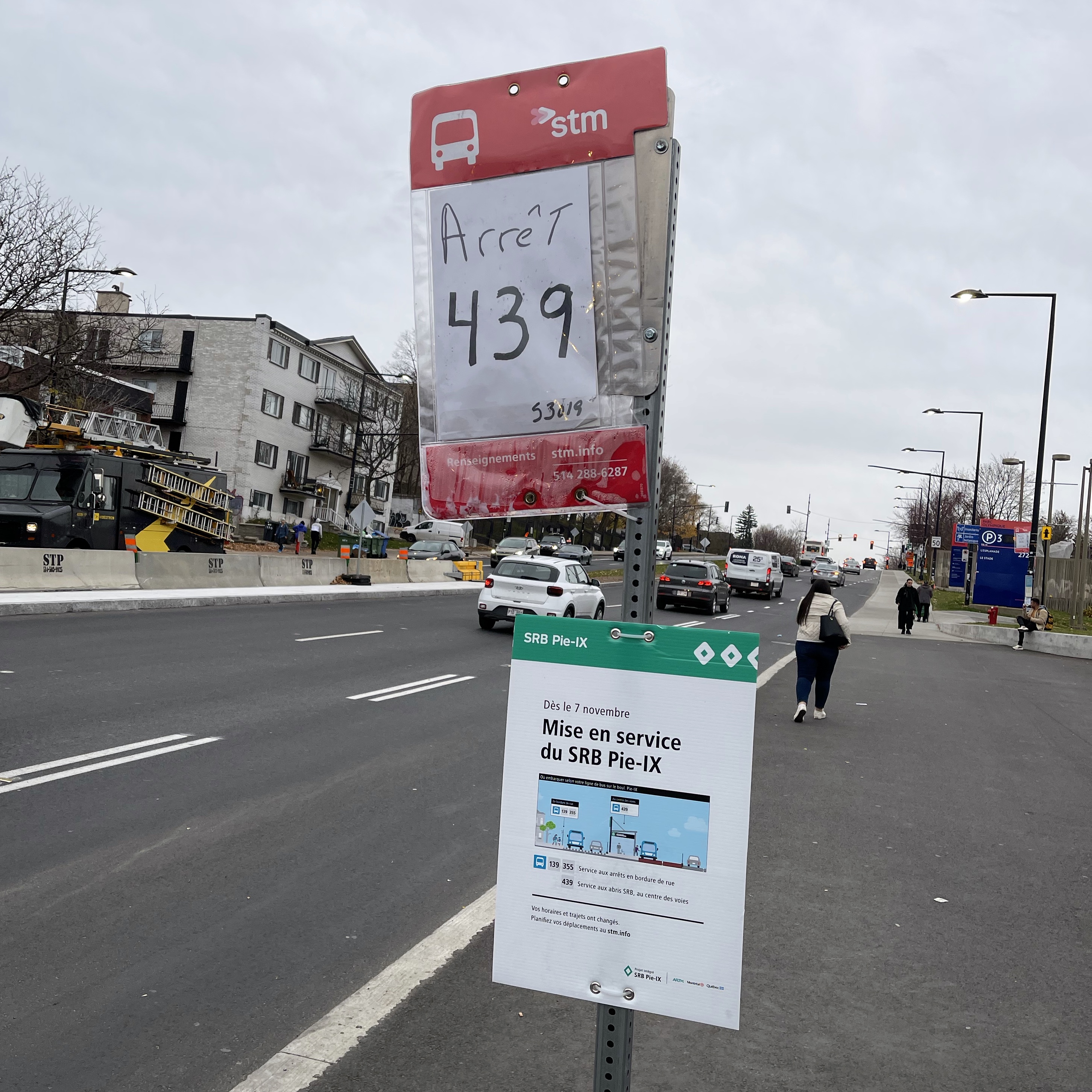
I am aware there wasn’t funding to extend the system down to the southern end of Pie IX, but given there was at least a year of serious construction around this area I’m surprised to see no BRT infrastructure was built. I was expecting underground tunnels from the Metro directly into a BRT station on the central reservation to make an integrated transfer, so this falls well short of my assumptions.
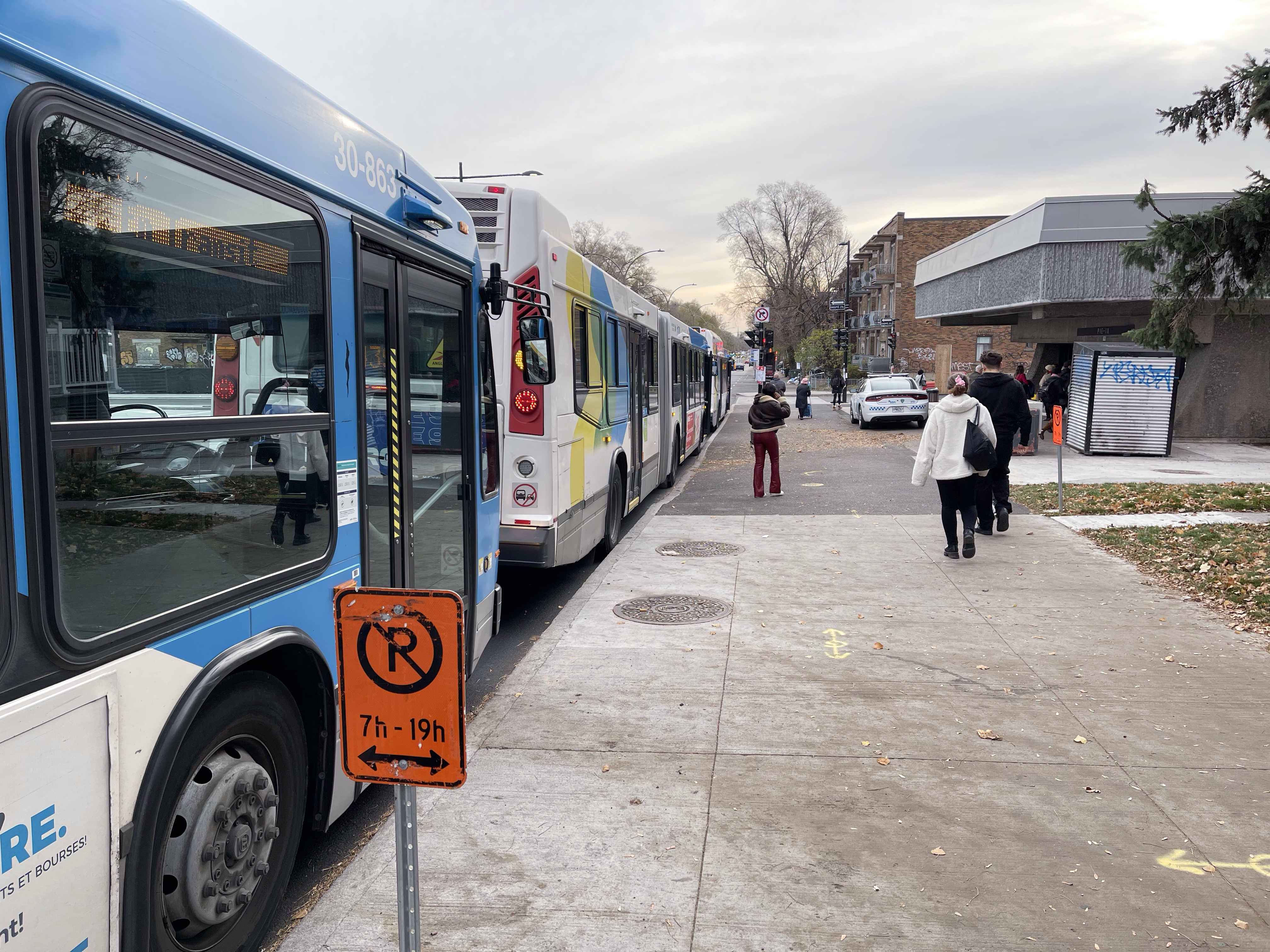
Whilst I’ll give credit for situating the stops right outside the Metro station’s entrances, there is still no shelter and passengers are made to wait exposed to the elements and passing traffic. More so, this will be the first impression new riders are greeted with and from an optics perspective, this seems very bad indeed.
I have however heard that they’re future-proofing the other Metro station where the BRT will meet the Blue Line extension in a few years, and that transfer should be much better implemented.
If you’re wondering about local buses, these continue to operate along with the rest of the traffic, and their stops are located on the sidewalk as you would expect. Those routes parallel the BRT, but make more frequent stops. Obviously they don’t gain any of the benefits of the buses in the dedicated BRT lanes.
S-Tier Transit?
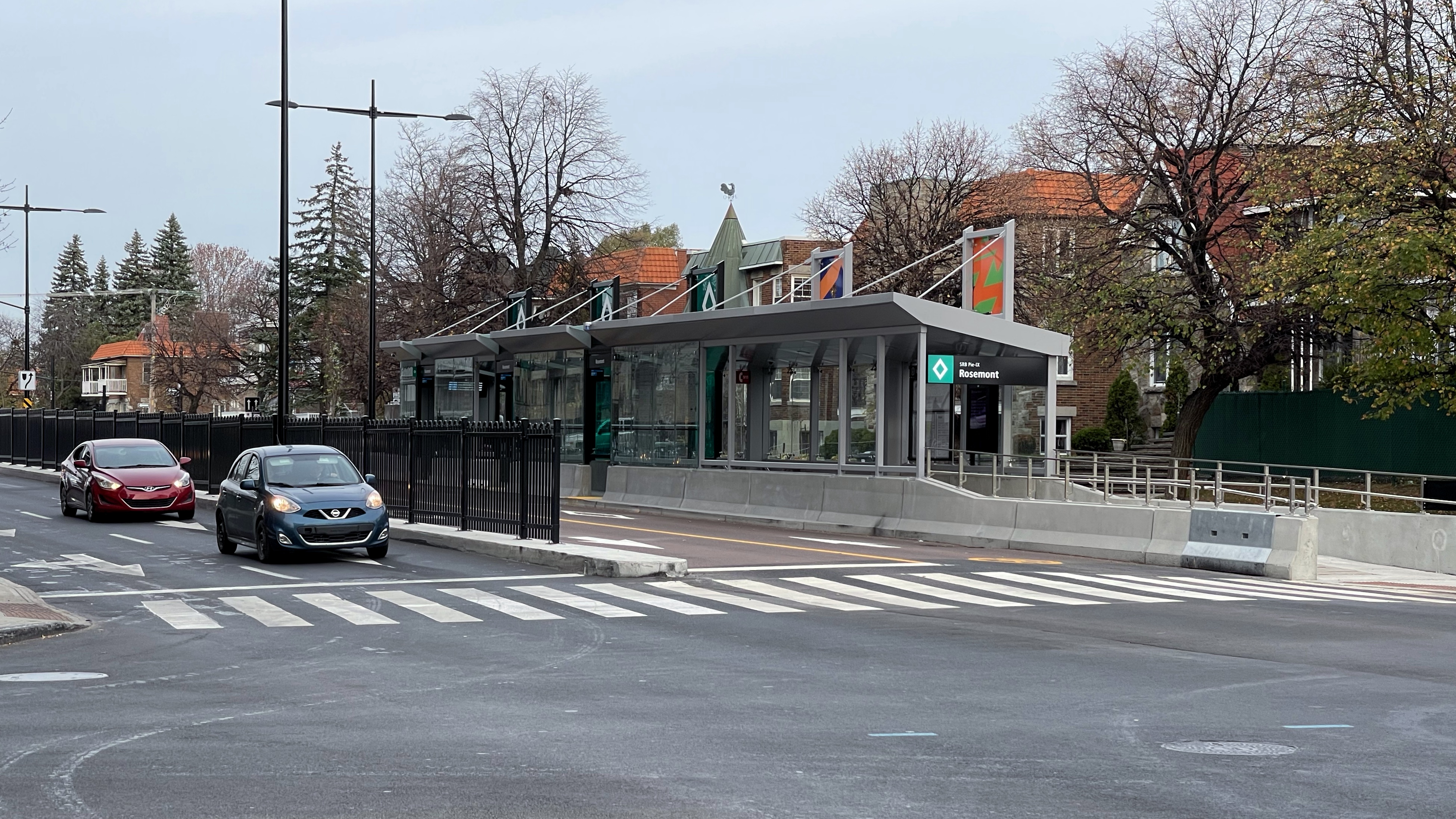
It’s all very well me giving subjective opinions on this, but there is a way of rating this BRT against measurable criteria, and it’s called The BRT Standard. Published by the ITDP, the idea is to rank BRTs from around the world by the same measurements. If you go to their website, you can check out a Google Sheet of many other BRTs.
I did have a stab at going through the scorecards and trying to rate the system, but I quickly realised I don’t have all the data points required to do a fair analysis. For example, you’d need to measure how far away the stops are from each other, or how closely the floor of the bus entrance matches the floor of the bus shelter. Clearly, the devil is in the details and I’d expect a team of experts would need to spend several days on the network to make a proper assessment.
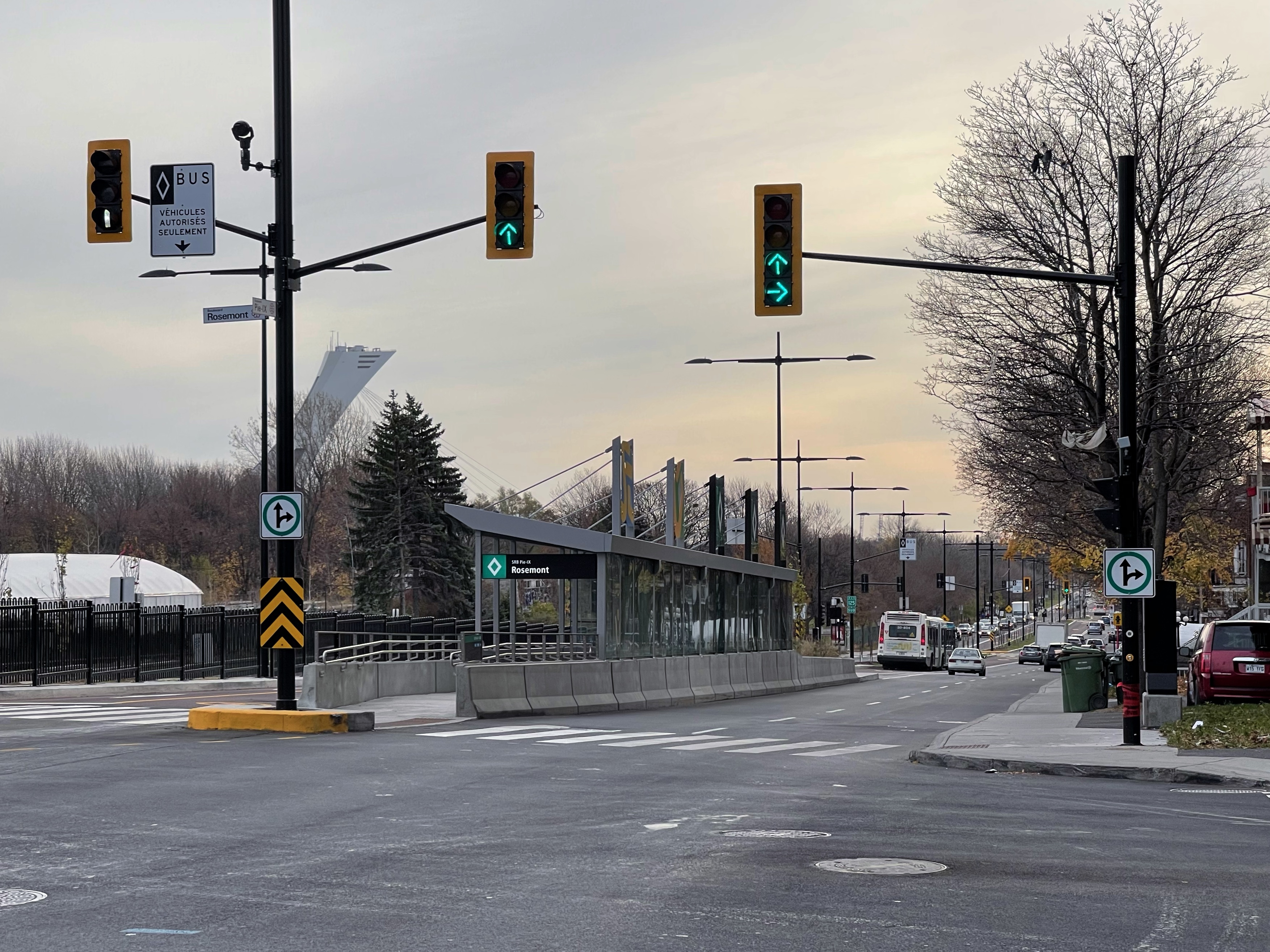
That said, putting my finger in the air, I’d say Montreal’s BRT falls quite short of some of the other BRTs around the world and would probably only attain a bronze ranking. That’s not to say this BRT isn’t good, but it’s not at the level of excellence we see from some of those other systems out there.
I’m hoping the ITDP eventually pay a visit to Montreal and rank our system. Such feedback would be extremely valuable if and when the authorities plan another BRT system in the city.
Questions Remain

Finally, let’s answer some wildcard questions which came to mind as I was using it.
Why Not Trams?
As stated in the STM’s BRT FAQ (emphasis mine):
Various electrification scenarios were analysed, first by the AMT in 2011 and then by the STM in 2013 and 2014.
Further to these studies, the scenario of an electric bus (or trolleybus) was not retained by the AMT, the City of Montréal or the STM, essentially due to very high costs, the impact of poles and overhead cables, and conflicts between the underground bases needed to support the power supply and municipal underground systems.
So it appears they considered a trolly-bus but the logistics and costs involved in making it work would have been prohibitive to the point the project wouldn’t have gotten off the ground. By extension, trams therefore couldn’t have worked either.
Which is a shame. I’m of the opinion that when you’re going to the trouble of doing so much infrastructure work anyway, it seems a pity not to go the full mile and do things properly. That said, it’s also hard to see the additional benefits of having trams over BRT would have been worth the costs and headaches which clearly would have been involved.
Should the BRT Exist on the Metro Map?
In my opinion, yes. Montreal’s metro map is reasonably sparse considering it has only four lines. I would suggest the map should be showing the overall rapid transit network in the city, and that would include the BRT, the REM and potentially some exo lines should any of them attain usable frequencies in the future. One could also argue other express bus routes could be added provided they have metro-like frequency and reliability, as demonstrated by this mockup.
My overwhelming wish for Montreal is to see it have a cohesive network rather than a disjointed collection of separate systems. Unifying Greater Montreal’s fare structure into zones was a first step in the right direction. Improved cartography could be another step forward.
Final Thoughts
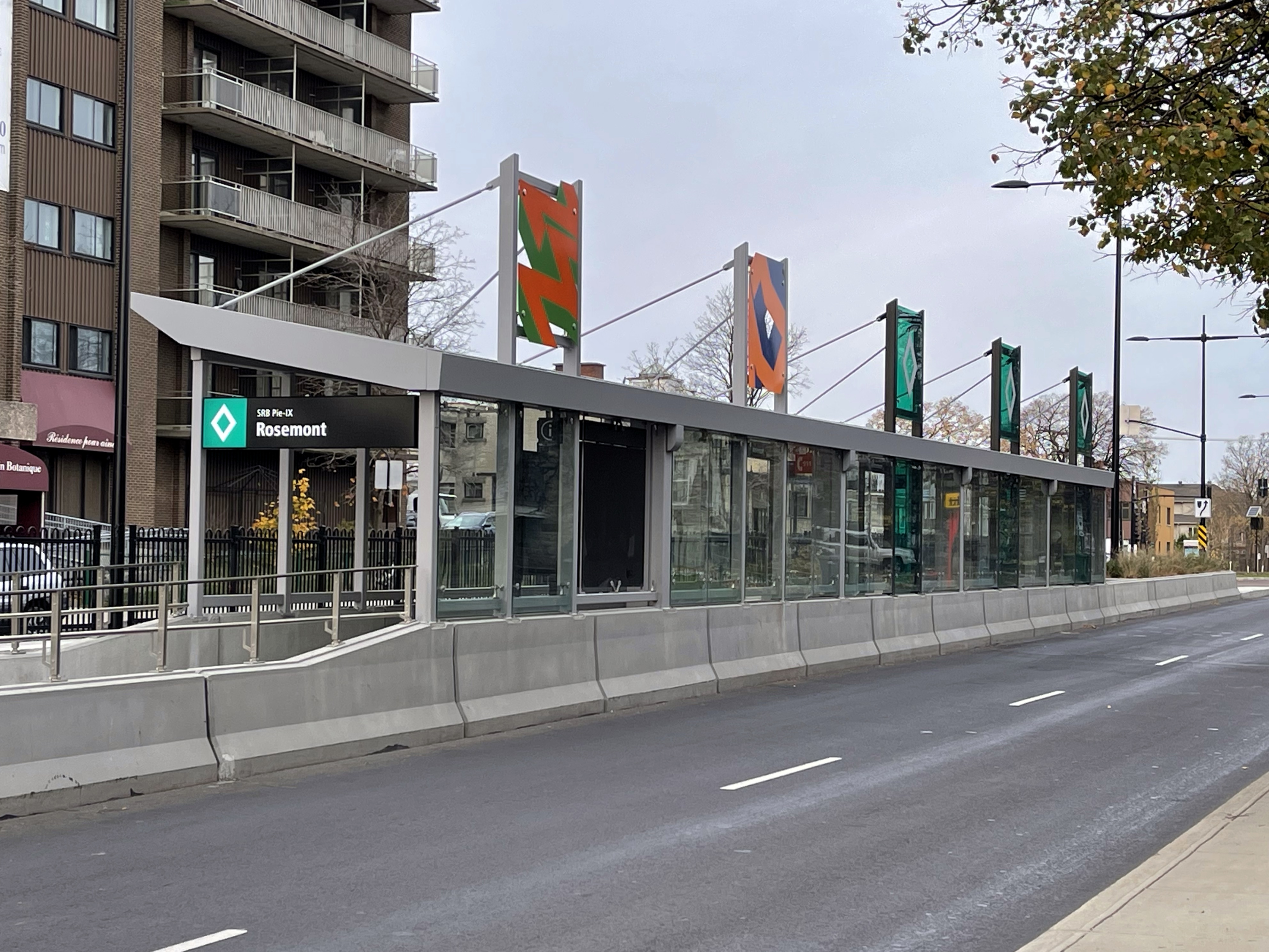
From my early impressions, this system is impressive. The stops are well spaced and the service is frequent and metro-like. The stations are pleasant and well sheltered. It shows whilst buses will never have the sexiness of light rail or metro lines, when implemented well they can be impactful.
It remains to be seen how successful this BRT system will be, and be aware this is not the first time BRT has been attempted along the Pie IX axis. However, I can only hope the authorities look towards implementing similar systems along other heavily used routes where the existing infrastructure would allow for it.
So, will I use it myself? It’s a little out of my way, but my local buses tend to be unreliable and can often get stuck in traffic or have odd diversions leading to some very frustrating journeys. If I use the BRT I get reliability in that:
- I know exactly how long it takes to walk to a BRT station
- I wait in comfort
- I know the bus should arrive quickly and won’t get stuck in traffic
- I know I can then make a quick connection with the metro
Having timed my journey, I can get from my son’s school after I drop him off to the cafe next to my office’s closest Metro station in roughly 45 minutes. I really like this constancy over a journey which will take 40 minutes on good days but may take 60 minutes or more when traffic is bad.
It’s hard to argue against knowing your trips will be consistent, even if you’re taking a slightly circuitous route.
I think at the end of the day, it’s about having control over your journey, and perhaps other travellers may also choose to go out of their way to benefit from a reliable service which takes the stress out of their commutes. Time will tell.
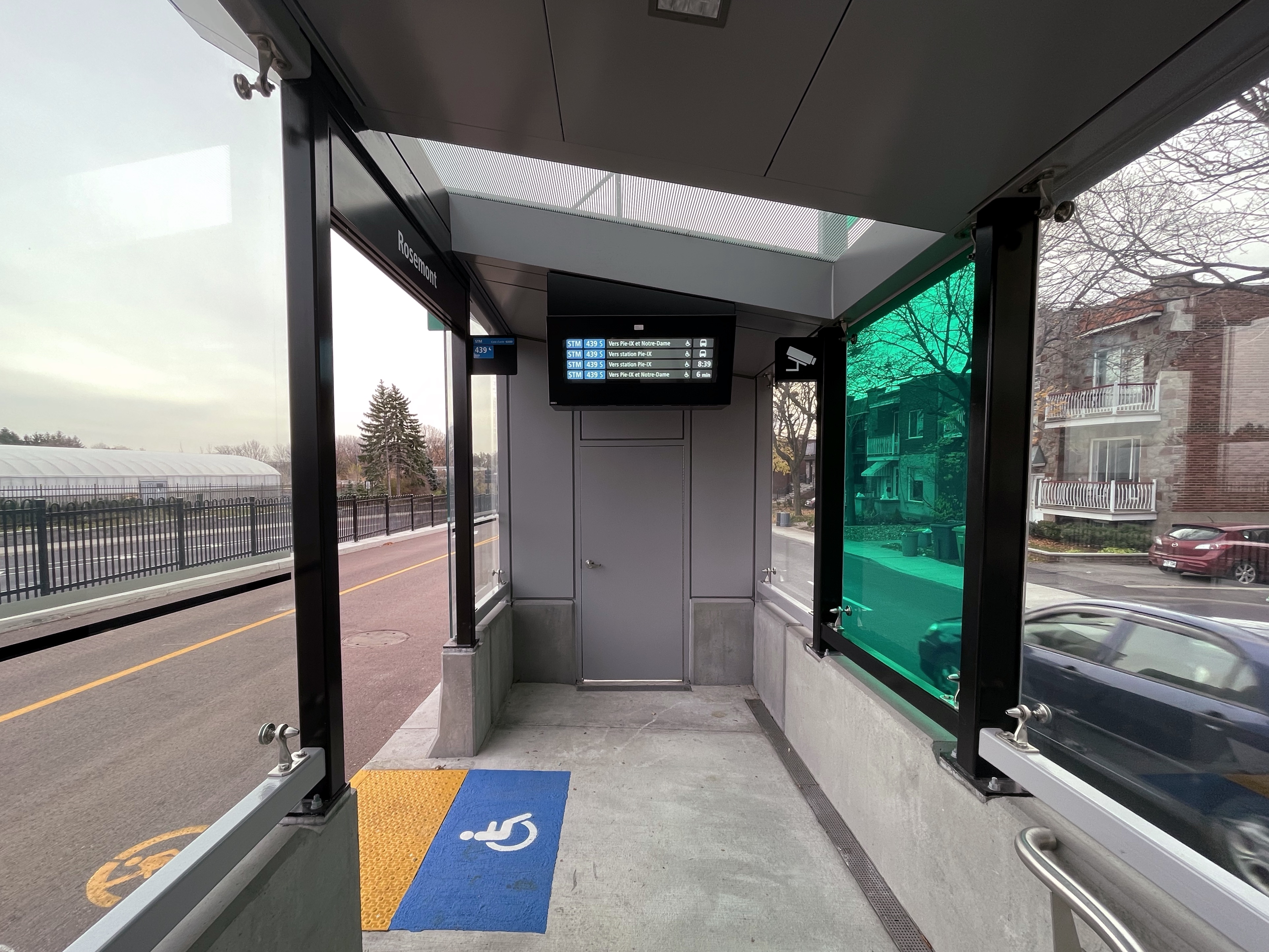
Addendum – March 2023
Since writing the original post I’ve had the opportunity to use the route a bit more, and also been able to explore its northern echelons. So, whilst I’ve not edited any of the content above, here’s where my thoughts are now:
- The route feels unfinished, so the ITDP probably wouldn’t want to conduct a review until everything is done. Sadly, this seems like it could be many many years away. Some of the unfinished items include:
- The area where the new Blue Line station at Jean-Talon is being developed requires a lengthy and slow local diversion around it. The buses divert on opposite sides of Pie-IX depending on the direction, and get stuck in traffic. The relocated stops are not central and so the benefits here of a BRT system are well and truly negated. It’s not clear what impact the diversion has on the schedule.
- As mentioned above, there’s no BRT stop at Pie-IX Metro, although this isn’t a big deal as the stops are right outside the entrances to the Metro.
- There’s no BRT south of Pie-IX Metro, although this is planned in the future. For now, it becomes a regular bus route losing the benefits of BRT. Some buses seem to turn back at the Metro station, which no doubt helps stabilise the schedule.
- The shelters handle the winter weather pretty well. They may not protect from the cold, but they do protect from the wind which removes the wind-chill factor. They’re also free from snow.
- Bus drivers seem prone to erratic behaviour which seems incompatible with running within a BRT system. For example:
- They skip stops when no one presses the bell, and occasionally miss people at the stations waiting for the bus as there’s not a clear line of sight for a bus driver to see if a station is populated or not. At least once the driver slammed on the breaks just in time to swerve in and stop.
- Some drivers aren’t great at aligning the bus doors with the gaps in the station. This leads to a small space people have to squeeze through.
- I’ve seen some non-articulated buses running which only use the front and middle entrances of the station.
- Following on from the last point, I’ve also noticed a reduction in articulated buses on other nearby routes, which makes me wonder if the existing bus fleet has been stretched thin by the introduction of this corridor.
- The articulated buses in use don’t seem suited to a mass-transit corridor:
- As mentioned earlier, the back doors aren’t wide enough and were originally designed just for disembarkation, but now they’re being used for boarding too.
- There’s simply not enough space for wheelchairs and pushchairs. There often seems to be more pushchairs on the bus than space allows for, leading to blocking.
- The buses could be wider. Since they travel – mostly – in a straight line and on a dedicated right of way, there should have been latitude for wider vehicles with more space inside. Of course, this issue can still be fixed when it becomes time to update the fleet.
- More doors on the buses would have been welcome, but this is harder to fix now the stations have been built.
- There’s not enough space to move around when the bus is crowded, and people have trouble getting to the door when its time for their stop. Since a BRT is supposed to be more akin to rapid transit it would have been better to have less seating and improve passenger flow within the bus.
- Although it wasn’t possible to electrify the route, it would have been nice to have a fleet of battery buses which charge at the ends of the routes. Montreal already has some of these on other routes complete with charging stations at the termini.
- The final stop on the Island, on Henri-Bourassa Boulevard is a regular bus stop which doesn’t connect well to other bus routes in the area. It would have been nice to build a proper bus interchange so people could continue their journeys more easily.
- And ending on a positive: The reliability and frequency still seems good, even considering the diversions! These are always the most important things for a transit system to get right.
The updated conclusion? This BRT isn’t really a completed project, Parts of it – Around Jean-Talon and south of Pie-IX Metro – need to be finished, or even started. The existing buses aren’t really fit for purpose either.
Montreal has been transit-starved since the original Metro system on the island was completed in the 70’s, a project which should have continued until the entire city and neighbouring municipalities were part of a wide network. So, any new rapid transit project dazzles when it first arrives. But on further reflection I have to say whilst this BRT is very welcome – even in its currently truncated form – it still remains a small drop in the ocean compared to what this city needs and deserves.
Addendum – May 2023
Writer Taras Grescoe (whom I quoted at the top of this article) has posted his own dispatch on the BRT this month, and it’s interesting to get the nuanced view of someone who’s ridden a few BRTs around the world. He seems to think Montreal’a BRT shows promise but needs some work to get to the standards of Asia or Latin America.
I feel like the BRT is a developing story, and it’ll be interesting to come back in a year or two to do a follow up and see how things have improved and whether any new systems are planned in the city.